Tips for Roasting Chicken
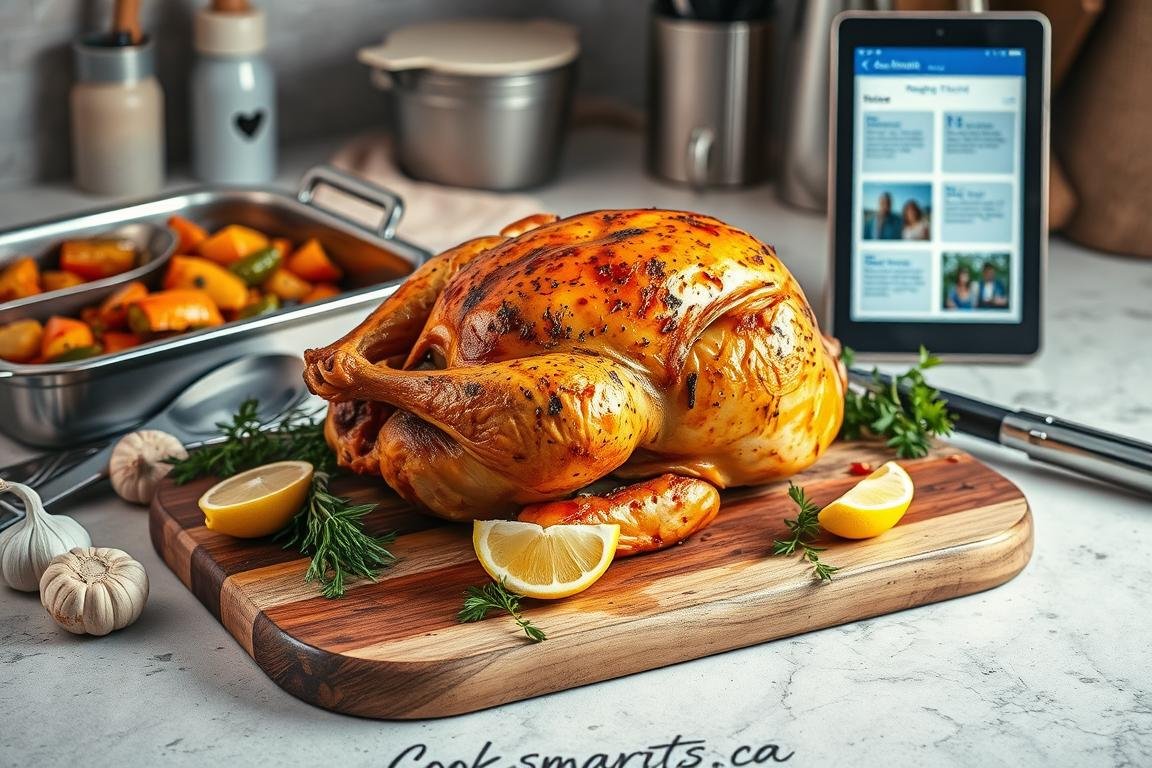
Roasting a chicken to perfect juiciness and crispy skin might seem hard. But, with the right Tips for Roasting Chicken, anyone can make a delicious roast. Think about the joy of having a perfectly roasted chicken from your own kitchen. You can also roast two chickens at once, perfect for a big meal or leftovers. But, how can you make sure your chicken comes out great?
To master roasting or to try new chicken recipes, knowing how to season, and control temperature is key. Roasting at 400 to 425 degrees Fahrenheit gets you juicy meat and crispy skin. Also, patience is crucial. Let your chicken rest for at least 15 minutes after roasting. This step makes a big difference in taste. Let’s explore some roasting techniques to improve your chicken-cooking skills.
Key Takeaways
- Roasting chicken at home makes it tastier and gives a feeling of accomplishment.
- The right oven temperature is important for a perfectly roasted chicken.
- Resting your chicken after roasting makes it moist and tender.
- Making stock from leftovers is both eco-friendly and saves money.
- A chicken between 3½-4 pounds is best, and brining can make it tender and tasty.
- Aromatics and basting can improve flavor and make the skin crispier.
- Adding a jus from the drippings can turn your roast into a gourmet dish.
Understanding Chicken Cuts and Types
The cut of chicken you pick is crucial for roasting. It affects the flavor and texture deeply. Knowing about various chicken cuts enhances your cooking, making your meals taste better.
Whole Chickens vs. Parts
A whole chicken or its parts? Your choice should depend on the cooking method and what you want as the result. A whole chicken keeps moisture, which means juicy chicken meat and crispy chicken skin. On the other hand, chicken parts like breasts or thighs cook faster. Yet, they need special care to stay moist and tasty.
Best Varieties for Roasting
The chicken type also plays a big role in how your roast turns out. Jersey Giant and Plymouth Rock are great for roasting. They’re plump and juicy. Heritage breed chickens have a strong flavor and firm texture. They really make your dish stand out.
Choosing Organic or Conventional
It’s essential to decide between organic and conventional chicken. Organic chickens usually have a rich flavor and firm texture, improving your roast. They’re free-range and eat organic feed. Conventional chickens are easier to find and more affordable. But, they might not taste as rich as organic ones.
Here’s a table showing various chicken cuts and what makes them unique. It helps you decide which to use:
| Cut | Description | Typical Use |
|---|---|---|
| Breast | Lean white meat | Roasting, grilling |
| Thigh | Rich dark meat | Braising, slow cooking |
| Drumstick | Flavorful dark meat | Barbecuing, frying |
| Wings | Tender white meat | Frying, baking |
| Neck | Collagen-rich | Soups, broths |
| Back | Fatty, rich in collagen | Broths, stocks |
Choosing the right chicken and cut is key to your cooking. It can enhance the flavor and texture of your meals. Whether you go for a whole chicken or parts, your decision can lead to a perfect roast. Your meal will boast juicy chicken meat and crispy chicken skin.
Essential Tools for Roasting Chicken
Getting ready to roast the perfect chicken starts with the right tools. These tools affect cooking times and flavors. Using the right equipment ensures precise roasting temperatures and perfect seasoning blends.
Roasting Pans: What to Look For
A good roasting pan makes sure your chicken cooks well and gets golden brown. Whether you choose cast iron or stainless steel, these pans keep roasting temperatures high. Look for a pan that spreads heat well to improve flavor and texture.
Meat Thermometer: Why You Need One
A reliable meat thermometer helps avoid over or under cooking. It checks your chicken’s internal temperature, ensuring it’s safe at 165°F as per USDA. This tool is key for juicy and tasty poultry.
Additional Kitchen Gadgets
Other tools like kitchen scissors, a chef’s knife, and storage solutions also improve roasting. Joyce Chen Kitchen Scissors are great for spatchcocking a chicken. Devices like the ChefsTemp ProTemp Wireless Meat Thermometer have Bluetooth, making monitoring easy.
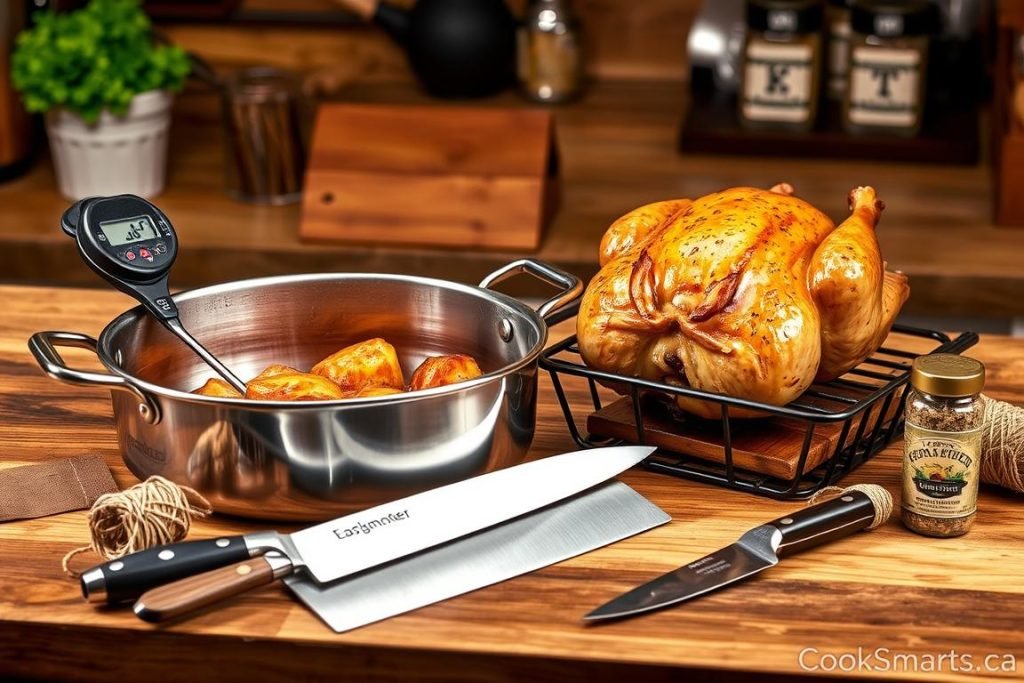
When you prepare for your next cooking adventure, these tools are wise choices. They help you roast the perfect chicken with ideal roasting temperatures and seasoning blends. They make cooking easier and more fun.
Preparing Your Chicken for Roasting
Getting ready to roast a chicken involves several key steps. Things like trimming, cleaning, and seasoning are vital. They make sure your roast tastes amazing.
Trimming and Cleaning
Start by trimming off extra fat and removing the giblets. This helps with both cleanliness and cooking evenly. Preparing this way leads to crispier skin and better cooking all around.

Dry Brining: The Secret Weapon
Dry brining involves sprinkling the chicken with kosher salt. Let it sit in the fridge for up to 24 hours. This seasons the chicken and pulls out moisture for crispy skin.
During this time, the salt soaks into the meat. It helps the chicken stay moist and flavorful. This makes carving easy and the slices perfect.
Seasoning Options: Herbs and Spices
After brining, dry off the chicken and add herbs and spices. Use rosemary, thyme, pepper, and garlic for a great mix. These enhance the chicken’s flavor without taking over.
Consider stuffing the cavity with lemon slices and herbs, too. This adds fragrance and helps the chicken stay moist while cooking.
Basting the chicken as it roasts can add more flavor and moisture. Using dry brining and good basting techniques can really impress your guests.
Learning these preparation basics will make your roast chicken stand out. Your guests will love it and you’ll get lots of compliments.
The Importance of Temperature in Roasting
Learning to roast chicken involves careful temperature control. To get crispy skin and juicy chicken meat, know the right temperatures. It’s also key to handle the chicken well after roasting.
Ideal Roasting Temperatures
For perfect roasting, keep your oven hot. Chef Bradley Borchardt suggests cooking a whole chicken at 400 degrees Fahrenheit. You should roast it for 40 to 60 minutes. Aim for an internal temperature of 175 degrees Fahrenheit in the leg. The breast should reach 160 degrees Fahrenheit. This makes the skin crisp and keeps the inside moist.
Preheating Your Oven Properly
Don’t forget to preheat the oven before starting. Cooking poultry at temperatures below 325 degrees Fahrenheit is risky, says the USDA. It can cause illness. Heat your oven to at least 400 degrees Fahrenheit for safe and ideal roasting.

Resting Time After Roasting
After roasting your chicken, let it rest. Give it at least 10 minutes before cutting. This time allows juices to move through the meat. It makes sure every slice is juicy chicken meat.
| Reward | Technique | Temperature (°F) | Time |
|---|---|---|---|
| Crispy Skin | Preheating Oven | 400 | 40-60 minutes |
| Juicy Meat | Resting | N/A | 10 minutes |
Grasping these essential tips and using them can seriously improve your chicken roasting game. It will please anyone who tries it.
Techniques for Achieving Crispy Skin
Getting crispy chicken skin starts before the oven. We’ll look at ways to roast for maximum crispiness. These include air drying and finishing with high heat.
Air Drying for Crispiness
Air drying is key for crispy skin. Leave the chicken uncovered in the fridge for 24 hours. This dries out the skin, making it ready to crisp up when cooked.
Basting vs. Not Basting
People have different views on basting. But our tests show that fats like butter help get the skin crispy. If you baste, use fats to keep flavors rich and the skin crispy.
High-Heat Finishing Methods
A blast of high heat at the end is vital. Start by roasting at a moderate temperature to cook it well. Then, up the oven to 450°F for the last minutes. This ensures the skin gets perfectly crispy.

| Method | Description | Outcome |
|---|---|---|
| Air Drying | Chicken uncovered in fridge 24 hours | Golden color, very crispy skin |
| Basting with Fat | Minimal basting using fats like oil | Rich color, enhanced crispiness |
| High Heat Finish | Last few minutes at 450°F | Deeply crispy and browned skin |
These roasting techniques guarantee crispy chicken skin. It’s not just about the oven. It starts with the prep. Air drying, basting, and a high-heat finish all play a part in crispy skin.
Flavoring Your Roast Chicken
Preparing a roast chicken is an art, especially when it comes to flavor. It’s not just about how you cook it. It’s also about the spices and special touches you add. Let’s dive into making your roast chicken a gourmet dish.
Marinades and Rubs
Marinades and rubs can make your chicken taste amazing. Use things like honey, tangerine juice, and maple syrup. Mix them with spices like cumin and sweet paprika. This will season the meat and make a tasty crust. For a different flavor, try soy sauce, garlic, and ginger. It gives an Asian-inspired taste.
Stuffing Options for Added Flavor
Stuffing your chicken does more than just fill it up. It makes it flavorful from the inside. Use onion and garlic for a savory taste. Adding fruits like dates or figs can bring in some sweetness. Herbs like cilantro or mint will add a fresh touch to every bite.
Citrus and Aromatic Enhancements
Citrus and aromatic seasonings make your chicken lively and aromatic. Put lime or tangerine slices inside or under the skin. This adds a nice citrusy flavor. Add star anise or cloves for a warm, spicy taste. This makes the chicken delightful to eat.
To make sure your chicken is not only tasty but also perfectly cooked, roast it at 400 degrees Fahrenheit. It should reach an internal temperature of 165 degrees Fahrenheit. This method keeps the meat juicy and flavorful.
Follow these tips to give your meals a culinary edge. These ideas are perfect for dinner parties or family meals. The right marinades, stuffings, and seasonings can turn a simple roast chicken into a special feast.
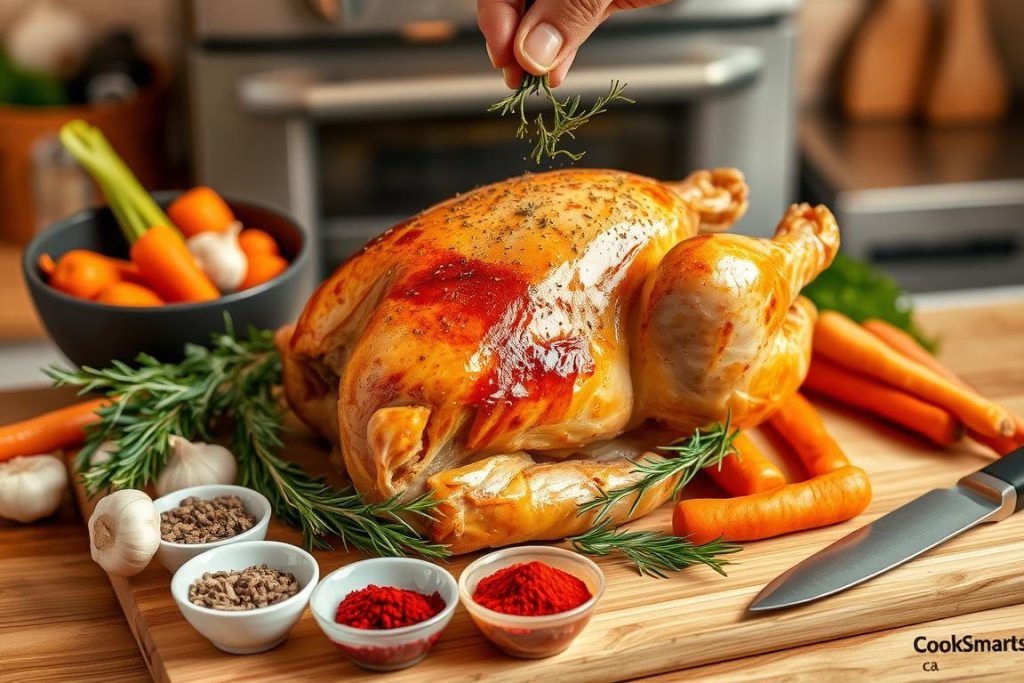
Cooking Times: How Long to Roast Chicken
Getting your roast chicken just right isn’t just about seasoning. It’s also about knowing the right cooking times and temperatures. Whether it’s a Sunday dinner or a special meal, this knowledge can make your food taste amazing.
Whole Chickens vs. Bone-in Parts
Roasting a whole chicken is usually easier because the heat spreads more evenly. But, cooking bone-in parts needs more care to cook each piece right. A whole chicken cooks faster than parts. This is because it keeps moisture better, which helps it heat up.
Using Weight as a Guide
The weight of your chicken tells you how long to roast it. Cooking times change a lot based on the chicken’s size. For example, a 2.5 to 3.5 lbs chicken usually roasts in 1 hour and 15 minutes to 1 hour and 25 minutes.
Adjusting for Stuffed vs. Unstuffed
Stuffed chickens take longer to cook. The stuffing inside slows down heat getting to the chicken. You need to cook it longer to make sure everything is perfectly safe to eat.

| Weight | Regular Method | High Heat Method | Spatchcocked (400°F) |
|---|---|---|---|
| 2.5 to 3 lbs | 1 hour 15 minutes | 1 hour | N/A |
| 3 to 3.5 lbs | 1 hour 25 minutes | 1 hour 10 minutes | N/A |
| 7 to 7.5 lbs | 2 hours 45 minutes | 2 hours 30 minutes | N/A |
With this guide, you can roast a chicken to be golden outside and juicy inside. Remember, good roasting is about both time and temperature.
Troubleshooting Common Roasting Issues
Even seasoned cooks can face challenges when roasting chicken. Getting juicy meat and crispy skin can be tricky. Let’s explore common problems and solutions for perfect poultry every time.
What to Do If It’s Not Browning
If your chicken isn’t getting that golden-brown look, a few things could be wrong. Maybe the oven isn’t hot enough, or the chicken is too moist. Try raising the oven’s temperature or broiling the chicken for a bit. Make sure to dry the skin well before roasting. This tactic is used by many butchers to get crispy skin.
Dealing with Dry Meat
Dry chicken often means it’s overcooked or cooked at too high a temperature. Always use a meat thermometer to avoid overcooking. Plenty of people find using low heat for a longer time helps keep meat juicy. Letting your chicken rest after cooking helps juices spread in the meat.
How to Fix Undercooked Chicken
Undercooked chicken isn’t just unsatisfying; it’s also a health risk. If it’s not fully cooked, put it back in the oven. Keep an eye on the internal temp. A steady 165°F (74°C) ensures it’s cooked safely.

Troubleshooting your chicken roasting technique can turn an okay meal into an amazing one. Knowing how to fix common roasting issues means you’ll nail the perfect roasted chicken every time.
Leftover Chicken Ideas
Using leftover roast chicken for new meals saves money and adds variety to your meals. You can make today’s meals exciting using yesterday’s chicken. You’ll learn to pair them with sides and how to store them right.
Easy Recipes for Leftovers
Want a quick meal with leftover chicken? Try Chicken Biryani. It’s tasty, with a 4.67 rating from 18 votes. You need 400g of chicken, 300g basmati rice, and 400ml coconut milk. Add crispy poppadoms or cucumber raita for extra flavor. It only takes 25 minutes, ideal for a busy night.
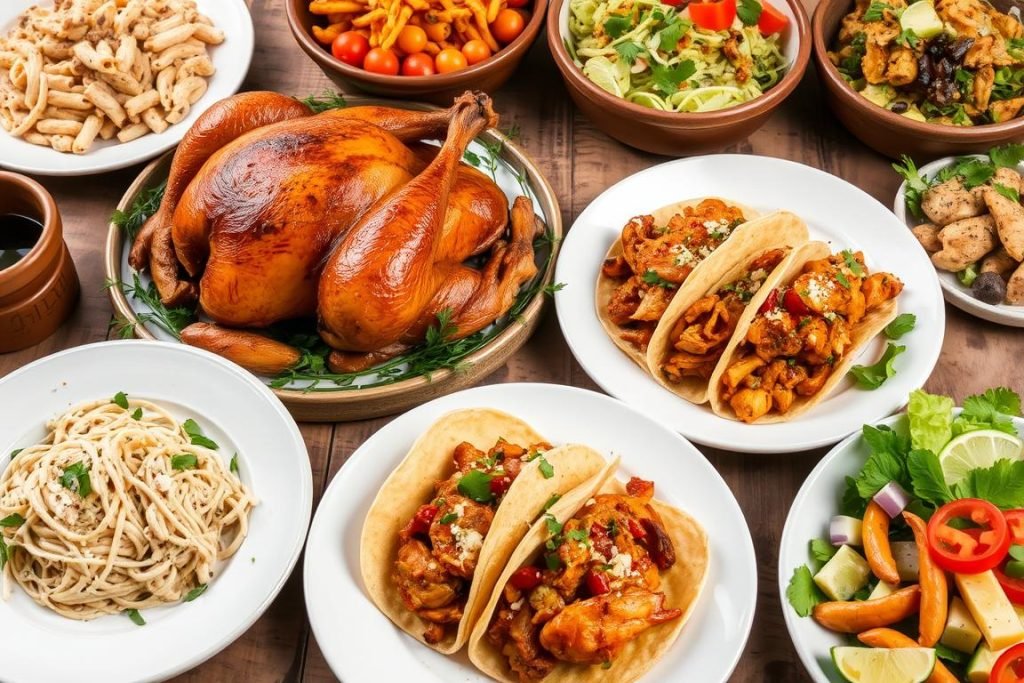
Creative Remakes: From Salads to Soups
You have 24 chicken recipe ideas to try. For a light meal, mix chicken with greens, nuts, and dressing for a salad. Or make a warm chicken soup with veggies, noodles, and stock. It’s perfect with crusty bread.
Storing and Reheating Safely
Storing and reheating leftover chicken right is key. Keep it in the fridge. When reheating, make sure it’s at 165°F. This keeps it tasty and safe. Try to eat it within three to four days.
These ideas make leftover chicken exciting. You can try a rich biryani or a healthy soup. With so many recipes, your meals will always be interesting.
Hosting Tips for Serving Roast Chicken
Learning to roast chicken is the first step to a memorable dinner. It’s more than just the meal; it’s about serving your perfectly cooked chicken with flair. Choosing the right side dishes and setting a wonderful dinner mood will showcase your cooking skills.
Plating and Presentation Tips
Your roast chicken must look as good as it tastes. Carve it carefully on a warm platter to highlight its golden skin and juicy meat. Add lemon wedges and herbs like rosemary for extra beauty and taste. These details make the dish not only tastier but also picture-perfect, promising a feast for the eyes and palate.
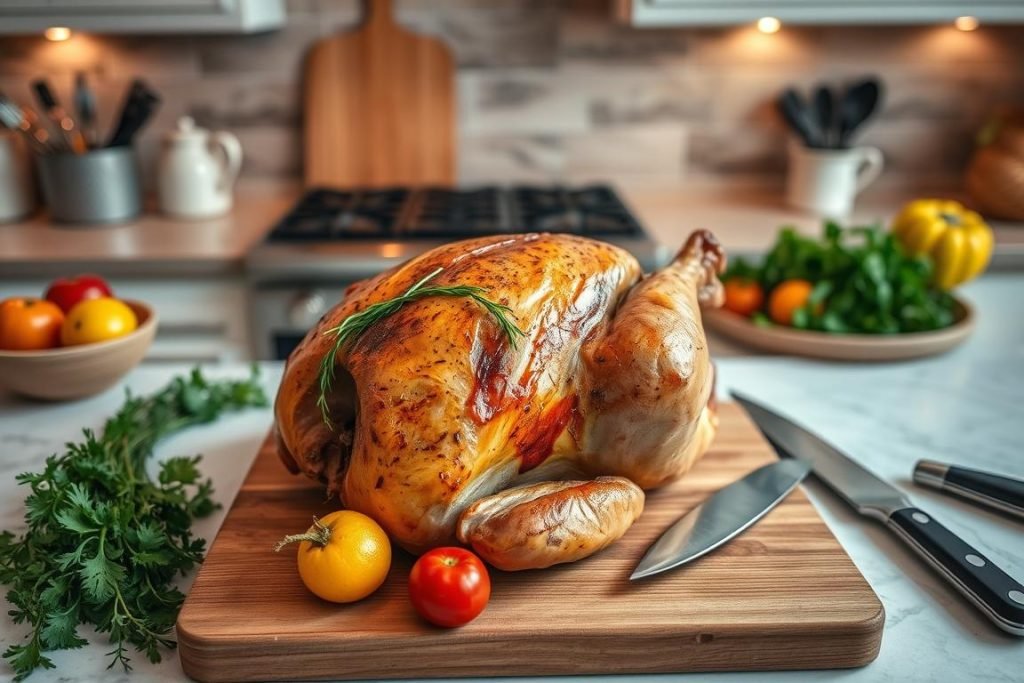
Sides That Pair Perfectly
Choosing the right side dish pairings is key. They should enhance, not overpower, the chicken’s flavors. Roasted root vegetables add sweetness and earthiness. On the other hand, a zesty salad or creamy polenta offers a fresh contrast to the chicken’s crisp skin.
Creating a Captivating Dinner Atmosphere
The smell of roasted chicken begins the experience, but the atmosphere brings it to life. Soft lights, candles, and soothing music create a warm setting. Include a simple cocktail like a Campari Rosé Spritz to welcome your guests and join in the fun.
- Roasted Broccolini with a tangy dressing – perfect for a burst of freshness.
- Winter Greens Salad with Pecorino Dressing – a sharp yet subtle accompaniment.
- Cheesy Polenta – adds a creamy, comforting base to your dish.
By focusing on these details, your dinner won’t just show off your tips for roasting chicken. It will also create a dining experience everyone remembers.
Final Thoughts on Roast Chicken Mastery
Mastering roast chicken is a journey. It’s ideal for both simple meals and grand dinner events. Exploring the history of “Spatchcock” reveals the deep roots of modern roasting. Plus, making a succulent BBQ chicken in 60 minutes is a skill that blends precision and tradition.
Embracing Experimentation
Roasting techniques are diverse. You can start with the chicken breast down for an even roast. Use kitchen shears or a knife to butterfly it. Covering the chicken with bacon or brushing it with butter can prevent the breast meat from drying out. Trying new methods, like ensuring clear juices for doneness, is key. This is similar to adjusting positions in football to improve your game.
Embracing new roasting methods refines your cooking skills. It’s about being open to change and growth.
Continuous Learning: Recipes and Techniques
Gaining skills in roasting and carving is like knowing all plays in football. Each attempt lets you explore different flavors. Matching a roasted chicken with just the right wine enhances the meal. Set your oven to 425 degrees F and each cooking session will deepen your skills. This journey enriches your meals with lean protein, vegetables, and starches.
Celebrating Your Culinary Achievements
After your roast chicken is done, take a moment to appreciate your efforts. Each carving, each pairing of wine and dish, and every savory bite is a mark of your dedication. Roast chicken is simple, yet it carries a rich history and the spirit of continuous improvement. Let the aroma of success fill your kitchen as you make your mark in the culinary world.